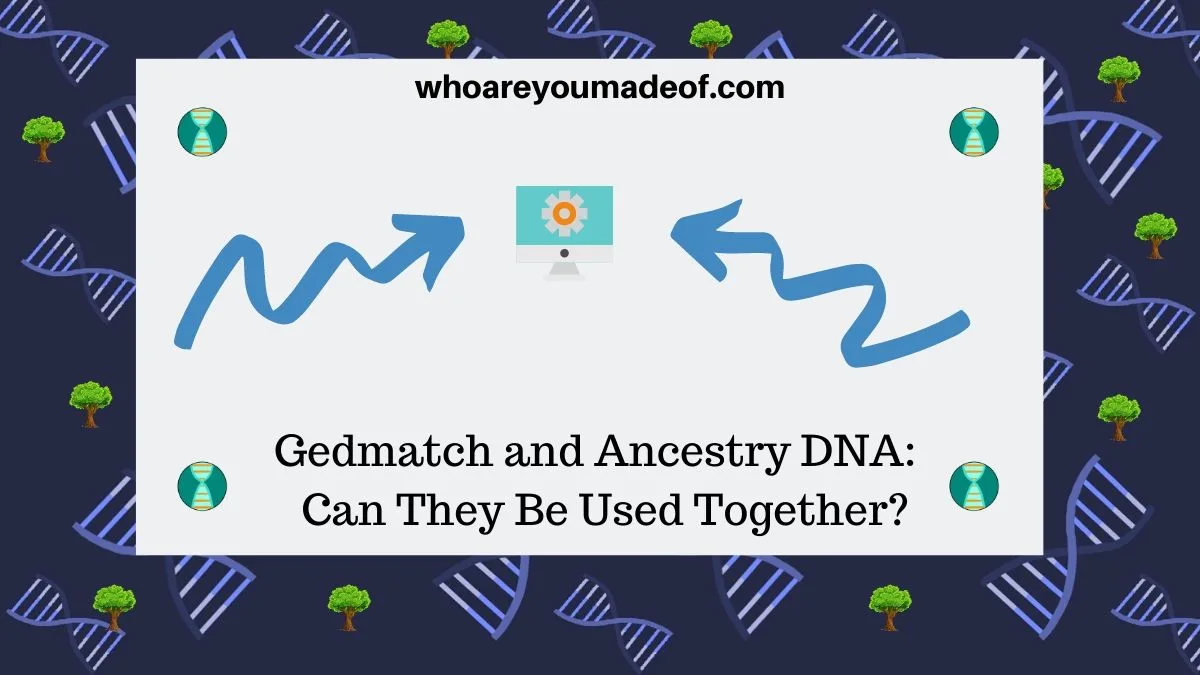If you tested your DNA with Ancestry and you want to use Gedmatch, you might want to know if they can be used together. In this post, find out exactly how to use Ancestry DNA with Gedmatch.
Testing with Ancestry DNA was a great decision. There is so much that you can learn right on the Ancestry site about your ancestors through your DNA matches and your ethnicity estimate.
You might have heard that many sites allow you to download your DNA. Furthermore, you might know that there are other sites that accept DNA uploads allowing you to learn even more from your DNA results.
Yes, it's true. You can use your DNA file from Ancestry on other websites. Imagine - you can take just one DNA test and keep learning on other sites!

Gedmatch is a very useful website where you can use your Ancestry DNA information to learn even more from your genome.
Can you use Ancestry DNA on Gedmatch?
Yes, you can use your Ancestry DNA results on Gedmatch. This is done by downloading your DNA into a file, which is then uploaded to the free Gedmatch site.
In fact, using Gedmatch in combination with Ancestry DNA is an excellent way to get more information from your DNA. The best part is that you don't even have to take another DNA test.
Gedmatch is not a DNA testing company. Instead, anyone who has tested their DNA with the major testing companies can download their DNA and upload it to Gedmatch.
The result is that Gedmatch is a very different website than Ancestry DNA. Information from these two websites, used together, can prove to be a powerful tool in building your family tree and learning who your ancestors were.
How is Gedmatch different than Ancestry DNA?
Since Gedmatch accepts DNA uploads from several different testing companies, you will be able to find DNA matches from multiple places on your DNA match list, which is also known as the Gedmatch One-to-One Comparison.
People who are on your Gedmatch DNA match list are generally related to you in some way.
You can use the free tools available on the site, like the chromosome browser (called the One-to-One Comparison) to examine your shared DNA more closely.
Our Ancestry DNA match list is a very extensive resource. In fact, most of us probably have several thousand DNA matches on the site.
Ancestry DNA is different than Gedmatch in that on Ancestry, the focus is on pure genealogy with shared DNA as a hint as to the possible relationship. It's helpful to do genealogy with Ancestry DNA because it is has the largest collection of online family trees, genealogy records, and potential DNA matches.
Even so, using Gedmatch in conjunction with your Ancestry results has its advantages. Gedmatch has a more science/tech focus, so you will be able to dive into the "genetic genealogy" aspect more profoundly on the site.
There are other features on Gedmatch that are primarily for fun. For example, you can find out if your parents were likely related using the Are Your Parents Related tool.
My favorite "just for fun" tool is the Archaic DNA Matches feature where you can find DNA matches from ancient DNA samples discovered around the world.
How to use Ancestry DNA on Gedmatch
As I mentioned earlier, your Gedmatch DNA list consists of those people who are on your One-to-One Comparison tool results. This is the place where most people begin exploring Gedmatch.
I always recommend analyzing your DNA match list on any site beginning with your top matches. These people are most closely related to you.
You might find that you have DNA matches on your Gedmatch list that also transferred their DNA from Ancestry. I love it when this happens.
When I spot a DNA match on Gedmatch that I recognize from Ancestry, I can find out more details about our genetic connection. For example, I can see the details about the size and location of our shared DNA segments.
Details like the size of the largest shared segment can provide clues as to how distant my common ancestor is with my Ancestry DNA match. I can check back with my match's family tree on Ancestry and have better luck finding our common ancestor.
Another favorite way to use Ancestry DNA on Gedmatch is to access the Admixture (heritage) calculators, which are effectually alternate "ethnicity estimates". You can use these numerous calculators to explore the regions in your DNA where your ancestors may have lived.
How to upload Ancestry DNA to Gedmatch
The process of getting your Ancestry DNA data to Gedmatch is very easy. You can download your Ancestry DNA file from your DNA test settings page.
Uploading your DNA file to Gedmatch is also a very easy process. The first step is to create a Gedmatch account.
Then, follow the instructions on your Gedmatch dashboard.
For further instructions about how to transfer your Ancestry DNA to Gedmatch, including detailed screenshots and explanations, please see the following post:
Conclusion
I hope that this post has helped you learn that you can use Ancestry DNA with Gedmatch, how the two sites are different, and exactly how to use the two together.
If you have any questions about something that you read in this post, or if you have specific question about how to use Ancestry DNA with Gedmatch, please feel free to join us in the discussion below.
Thanks for stopping by today!

